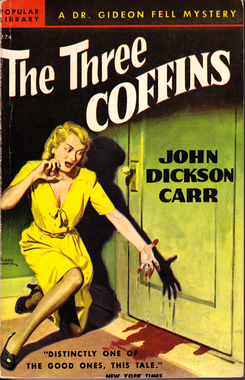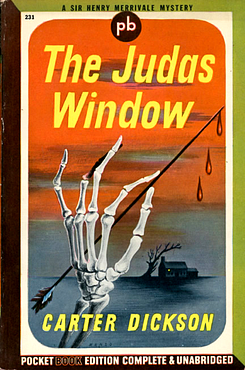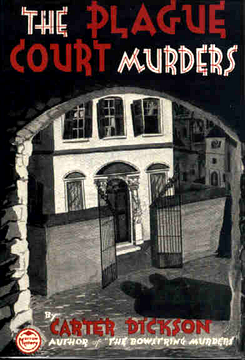
I used to think it would not be of much use to blog about English detective novels that are actually available via print on demand or Kindle, unlike many other classics. But then again, you could also see it the opposite way and think the mention of these novels is even more important considering efforts are made to make these available again. And since I knew I could not make a somewhat meaningful post on my recent reading of The Plague Court Murders without mentioning the other Carr novels I've read so far, I figured I might as well sum them up together.
The Three Coffins / The Hollow Man
Professor Grimaud is shot in his own study, which has been locked from the inside and under observation from the outside. No one saw the murderer enter the study and no footprints are found in the snow below the window or on the roof. At around the same time another man is found shot from close range, with the same weapon that killed Grimaud, in a cul-de-sac with no footprints and passengers saying they saw no one commit the crime.
The Three Coffins / The Hollow Man
Professor Grimaud is shot in his own study, which has been locked from the inside and under observation from the outside. No one saw the murderer enter the study and no footprints are found in the snow below the window or on the roof. At around the same time another man is found shot from close range, with the same weapon that killed Grimaud, in a cul-de-sac with no footprints and passengers saying they saw no one commit the crime.
The eerie talk on Grimaud's background and the possibility of a gruesome killer able to walk through locked doors combined with the impossible crime situations provide Carr's essence concentrated in what many believe to be his masterpiece. It certainly is an epitome, but it's more about the acrobatic shenanigans built around the locked room than the locked room itself what really sets this novel apart. It's very entertaining at that, but when you think about it, there's no need for either culprit or author to construct the crime in such an overly complex manner that makes the whole mystery rather improbable in the end. The clues are also of a rather debatable nature. I.e. for me this is not the best Carr novel I've read so far.
The Judas Window
James Answell is invited by his prospective father-in-law Avory Hume. They sit down in a room which is decorated with Hume's archery trophies and also related arrows. After Hume pours drinks from a decanter, Answell faints and realizes the drink must have been drugged. After he comes to, Answell sees Hume stabbed with one of said arrows while the windows are closed with metal shutters and the thick wooden door is locked and bolted. Answell gets accused of Hume's murder and Sir Henry Merrivale has to prove his innocence in court.
This was what I anticipated from Carr, the master of impossible crimes. The dreadful method of using a locked room murder scenario to put the blame one someone else is used in a very direct and unique way here and it's much less improbable and actually more solveable than The Three Coffins. The essential gimmick used for the murder is something probably nobody will come up with himself but even once it's explained there's still plenty of the mystery left. While the trick requires several premises not directly coming from the murderer himself, it's not that uncommon in detective fiction when you think about it and what this novel might lack for some in the atmosphere department, it definitely makes up with the trick even if the courtroom narrative was not my kind of thing and dragged a bit at times.
He Who Whispers
Miles Hammond is invited to a meeting of the Murder Club and Professor Rigaud tells him the story of Fay Seton:
She once worked with the Brookes family and was engaged to Harry Brooke, of which his father Howard did not approve. One day Howard planned on meeting Fay in the tower of the remains of a chateau. Harry and Rigaud leave Howard on the roof of said tower, but when they return after just 15 minutes they see him stabbed by a sword-cane which is found beside him broken into two pieces. The tower was under constant observation by a family picknicking nearby and apparently no one entered or left the tower in that time frame. The only one with a motive is Fay Seton, who is rumoured to be involved in vampirism.
And as fate would have it, Fay Seton turns out to be Miles' new librarian...
The first Carr novel that I actually liked as a novel just because of its narration and plot. The impossible crime is nothing to write home about, considering what Carr is capable of, but again it's actually imagineable and the way it's weaved into the plot works excellent and makes for an enthralling reading. If I recommend The Judas Window for its trick, I recommend this one for pure enjoyment and plotting skill. You can't go wrong with either of them.
The Plague Court Murders
Ken Blake and Inspector Masters are invited by Dean Halliday to witness a seance and experience the supposed haunting at his family estate Plague Court. Halliday's fiance, aunt and others are fooled by a psychic investigator called Roger Darworth and his medium Joseph. That night Darworth locks himself up alone in a small stone house of the estate during the seance and eventually he's found stabbed with the dagger of Louis Playge, who was a hangman's assistant during the times of the Black Death and was buried under a tree right next to said stone house, supposingly causing the estate's hauntings. The stone house is locked and bolted and the mud surrouning it is unbroken. All suspects were gathered in a room of the main house in the dark during the seance and no one could have done it since Darworth rang a bell on the verge of dying - everyone jumped up at that sound, the lights were turned on and everyone was still present...
Not bad overall. The most remarkable thing might be that there's actually a reason for the setting and atmosphere the murder is padded out and decorated with. Once you look through all the grotesqueness you might actually be able to figure out the intention behind everything and therefore also the howdunnit, but the whodunnit is still hidden behind clues I didn't catch because... I got rather bored halfway. But even considering those clues... I doubt anyone will notice what they hint at. The murder method itself also features a gimmick comparable to that in The Judas Window which plays an essential part in solving the mystery and while it gives away more of the overall solution in this case, it's actually more guessable and not so unusual in reality, as also pointed out by Merrivale in the novel itself.
However, and this goes for Carr in general, personally I began to wonder whether this grotesqueness is really necessary if all it actually does is to provide atmosphere and hide essential aspects for the solution. I used to think locked rooms are the most awesome field in detective fiction, but in retrospect I realized that my favorite locked rooms are actually those that might be set in eccentric places but do not rely on grotesqueness. And let's be honest: How many locked rooms are actually logical in terms of deduction progress and probable in terms of practicability? And the more bizarre the setting and murder get, the more you anticipate from the solution, even if that feeling or stance are not rational in any way. Of course paddings and coverings can be used in a satisfying way, but it's rather difficult to pull off.
You might prove me wrong - I would actually welcome that - but I kind of get why Ellery Queen were not known for locked room tricks but were famous for their complex constructions and logical deductions instead. When is a locked room actually as logically deducible as Queen's early cases? I can only think of Ayukawa Tetsuya's 赤い密室 right now. And while doing that, I notice that such logical locked rooms might be a bit too easy to solve exactly because they are so logical and point to only one possible solution...
Another thing: Strictly speaking, Queen's early cases consist of nothing but investigation between murder and solution. However I think the cousins managed to narrate this simple plot structure much more interesting than Carr does with all his suggestions of the supernatual and whatnot... might be a totally personal matter though as I'm still waiting for the Carr novel that will finally convert me into a fan. It might seem strange after what could almost be perceived as a rant by now, but I really wish I could appreciate Carr's work more than I do so far. But there's a difference between being thrilled just by Ellery looking at crime scenes, talking with suspects and commenting with deductions... and not finding anything particularly remarkable about the detective figure and his advancements in the plot on the other hand, as it's the case for me with Fell and Merrivale...
Nothing of this changes the fact that The Judas Window still is my favorite locked room trick after all, even if it's miles away from being one of my favorite detective novels. I'm beginning to feel schizophrenic somehow... but it seems like that's not only my "problem", but something many Japanese authors have to "deal" with as well.




I'm definitely also more of a Queen guy. Reading Carr just never gives me the excitement I feel whenever Ellery explains one of his deductions based on obvious and less obvious clues. Also, I never seem to be able to keep confusing Fell with Merrivale...
ReplyDeleteI did read all four of the novels discussed here (though for some sinister reason, I have no next to no memories of Plague Court...) and I liked The Judas Window the best, which is really the most down-to-earth of them all. The trick is just awesome and I love the courtroom setting.
By now, I have given up the idea of turning into a real Carr fan (though I have some expectations for he House in Goblin Wood), but I usually do appreciate his stories on a technical level...
Oh yeah now that you mention it, I forgot The House in Goblin Wood, which is also my favorite locked room short story. Well, it's kind of a tie between that one and 赤い密室, for totally different reasons. I still have to read the other stories in The Third Bullet though...
ReplyDeleteAnd yes, I miss that kind of fascination and excitement in Carr's novels too. Maybe that's also the reason why I didn't read more than two entries of the Nikaidou Ranko Series until now and ditched the third volume somewhere after the first 100 pages. I'm always baffled to see how many of his books you've read even though you usually prefer more urban and Queen-ish settings. Yokomizo not included of course ;)
Heathens, both of you! ;)
ReplyDeleteAll I can say in response is that I argued from your position when I first came across Carr and it took me a while before I truly appreciated his genius, but I already went over my conversion process in a comment on a precious post.
Re Plague Court, you might like to check the comments after this blog posting:-
ReplyDeletehttp://deathcanread.blogspot.co.at/2012/04/normal-0-14-false-false-false_28.html